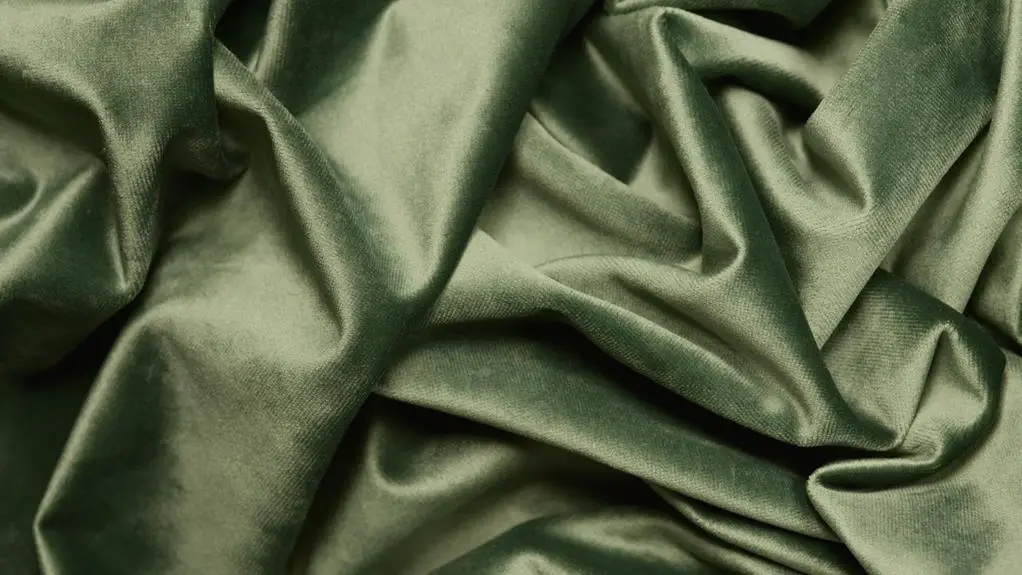When you're faced with wrinkles in muslin fabric, it's important to know how to handle them without damaging the material. You've got a few options at your disposal, like using a reliable iron or a garment steamer, both of which can effectively smooth out those pesky creases. However, the key lies in understanding the best techniques to ensure your fabric stays intact. Curious about the most effective methods and tools to achieve that crisp finish? Let's explore the steps you can take to keep your muslin looking its best.
Table of Contents
Key Takeaways
- Use a reliable iron on medium heat (around 375°F) with a pressing cloth to avoid scorching muslin fabric.
- Steaming is an eco-friendly option that relaxes fibers without direct heat; hang muslin for convenience.
- Mist the fabric with water before ironing or steaming to help release wrinkles more effectively.
- Wash muslin in cold or lukewarm water, and air dry to minimize wrinkling and maintain fabric quality.
Understanding Muslin Fabric
Muslin fabric, known for its lightweight and breathable qualities, is a versatile material often used in sewing and crafting. You'll find it comes in various weights and textures, making it suitable for everything from garments to home décor. This unbleached cotton fabric has a natural, soft finish that's easy to work with, which is one reason crafters love it.
When you choose muslin, you're getting a fabric that's not only economical but also adaptable. You can use it for mock-ups in fashion design, allowing you to test patterns and shapes without committing to more expensive fabrics. Additionally, its loose weave gives it a unique drape, perfect for flowing garments like dresses or skirts.
Muslin is also a favorite for quilting, as it provides a stable base for piecing together intricate designs. You can easily dye or print on muslin, allowing you to customize your projects.
However, its lightweight nature means it's prone to wrinkles, which is something you'll want to consider when working with it. Understanding these characteristics will help you make the most of muslin in your creative endeavors.
Best Tools for Removing Wrinkles
To effectively tackle wrinkles in muslin fabric, you'll want to gather a few essential tools that make the process quick and efficient.
First off, a reliable iron is a must-have. Look for one with adjustable heat settings since muslin can be sensitive to high temperatures. If you've got a steam option, even better!
Next, consider investing in a pressing cloth. This thin layer of fabric goes between the iron and your muslin, protecting it from direct heat and potential scorch marks. A spray bottle filled with water can also be handy. Lightly mist the fabric before ironing to help release the wrinkles more easily.
Don't forget a sturdy ironing board. A flat, stable surface gives you the leverage you need to work through those stubborn creases.
Lastly, if you often deal with muslin, a handheld garment steamer can be a lifesaver for quick touch-ups. It's portable and ideal for those hard-to-reach areas.
With these tools in hand, you're well-equipped to make your muslin fabric wrinkle-free and looking its best!
Steaming Techniques for Muslin
Steaming is one of the easiest ways to remove wrinkles from muslin fabric, and it offers several benefits.
You'll need the right steaming equipment to achieve the best results, so knowing what to use is key.
Let's explore the advantages of steaming and the tools you'll need to get started.
Benefits of Steaming
The gentle heat from steaming not only relaxes the fibers of muslin but also revitalizes its natural texture, making it an ideal method for wrinkle removal. When you steam muslin, you're not just getting rid of wrinkles; you're also enhancing the fabric's softness and drape. This technique helps maintain the integrity of the fibers, preventing damage that can occur with harsher methods like ironing.
Steaming is incredibly convenient, too. You can do it while the fabric is hanging, which saves time and hassle. Plus, it's an eco-friendly option that requires no chemicals, making it safe for you and the environment. The process is quick, allowing you to refresh your muslin garments or decor in just a few minutes.
Another significant benefit is that steaming can also kill bacteria and remove odors. This makes it perfect for fabrics that may not be washed frequently, like curtains or tablecloths. Overall, using steam not only smooths out wrinkles but also keeps your muslin looking fresh and clean, extending its lifespan and maintaining its beauty.
Steaming Equipment Needed
Having a reliable steamer makes the process of removing wrinkles from muslin both effective and efficient. When you're looking for the right steaming equipment, you'll want to consider a few key items.
First, invest in a good quality garment steamer. Look for one with a continuous steam function and a decent water tank capacity, so you won't have to refill it constantly.
Next, grab a sturdy hanger or a clothes rack. This will allow you to hang the muslin properly while you steam it, ensuring you can reach all areas without any hassle. If you're dealing with larger pieces, like curtains or tablecloths, a tall steamer will work wonders.
You might also want a pressing cloth. This thin fabric can protect the muslin from direct steam contact, especially if it's delicate.
Lastly, ensure you have a clean, flat surface nearby, like an ironing board, for any touch-ups. With the right equipment, you'll find that steaming your muslin is a breeze, leaving it wrinkle-free and looking fresh in no time.
Ironing Muslin Safely
When you're ready to iron muslin, it's crucial to know the optimal temperature to avoid damaging the fabric.
Using the right techniques can make a big difference in achieving a smooth finish without burns or creases.
Let's explore how to safely and effectively iron your muslin.
Optimal Ironing Temperature
To safely iron muslin fabric, aim for a medium heat setting, typically around 375°F (190°C), to prevent damage while effectively smoothing out wrinkles. Muslin is a lightweight cotton fabric, and using too high a temperature can scorch or burn it, ruining your fabric.
Before you start ironing, double-check that your iron is clean. Any residue on the soleplate can transfer to your muslin, leaving stains. If your iron has a steam function, you can use it, but ensure that the steam isn't too intense. Excessive moisture can lead to water spots or damage the fibers.
If you're unsure about the temperature, do a quick test on a small, hidden area of the fabric first. This will help you gauge how your specific muslin responds to the heat. If it wrinkles easily under your fingers, you might need to slightly adjust the temperature.
Always keep the iron moving to avoid concentrating heat on one spot for too long. This approach will help maintain the fabric's integrity while achieving a crisp, smooth finish.
Best Ironing Techniques
Using smooth, even strokes while ironing muslin helps prevent creases from forming as you work through the fabric. Start by ensuring your iron's soleplate is clean to avoid transferring any residue onto the muslin. Position the fabric flat on your ironing board, aligning the grain of the fabric to keep it from stretching.
Set your iron to the appropriate heat setting for muslin, usually a low to medium setting. If you're worried about scorching, place a pressing cloth between the iron and the fabric. This adds an extra layer of protection and helps diffuse the heat.
Begin at one corner and move in sections, ironing each part completely before moving on. Don't forget to lift the iron, rather than sliding it, to avoid stretching the fabric. For stubborn wrinkles, you can lightly mist the fabric with water before ironing to make the process easier.
Lastly, hang or lay the muslin flat immediately after ironing to maintain its smooth finish. Following these techniques will ensure your muslin looks crisp and wrinkle-free, ready for your next project.
Washing and Drying Tips
Before washing muslin fabric, always check the care label for specific instructions to ensure the best results. Generally, you'll want to use cold or lukewarm water, as hot water can shrink the fabric. Use a gentle cycle to avoid damaging the fibers. If your muslin has any stains, treat those areas with a mild detergent or stain remover before washing.
When it comes to drying, air drying is the safest option. Hang your muslin fabric on a clothesline or lay it flat on a clean surface. If you prefer using a dryer, opt for the low heat setting and remove the fabric while it's still slightly damp to prevent excessive wrinkling.
Avoid bleach and harsh chemicals, as they can weaken the fibers and alter the color of your muslin. If you're washing multiple pieces, keep similar colors together to prevent dye transfer.
Lastly, don't overload your washing machine; this ensures the fabric has enough room to move freely, resulting in less wrinkling. Following these washing and drying tips will help you maintain the quality of your muslin and make future wrinkle removal much easier.
Storing Muslin to Prevent Wrinkles
Proper storage of muslin fabric is essential for keeping wrinkles at bay and maintaining its crisp, clean appearance. To start, always fold your muslin neatly instead of just tossing it into a drawer. This prevents creases from forming. If you're short on space, consider rolling the fabric instead. Rolling helps retain its shape and minimizes the risk of wrinkles.
Next, choose a breathable storage solution. Avoid plastic bags as they can trap moisture, leading to mildew. Instead, opt for cotton storage bags or a clean, dry cotton sheet to wrap your muslin. This allows air circulation while protecting it from dust.
If you have multiple pieces of muslin, stack them with a layer of acid-free tissue paper between each one. This extra layer acts as a barrier and further reduces the chance of wrinkles.
Always store your muslin in a cool, dry place, away from direct sunlight to prevent fading and damage.
Frequently Asked Questions
Can I Use Fabric Softener on Muslin Fabric?
You can use fabric softener on muslin, but be cautious. It might affect the fabric's breathability and absorbency. Always test a small area first to ensure it doesn't alter the texture or color.
Is Muslin Fabric Prone to Shrinkage After Washing?
Yes, muslin fabric can shrink after washing, especially if it's not pre-washed. To minimize shrinkage, always wash it in cold water and avoid high heat when drying. You'll preserve its size and shape better.
How Often Should I Wash Muslin Items?
You should wash muslin items after every use to keep them fresh and clean, especially if they've been exposed to spills or dirt. Regular washing helps maintain their quality and prevents any potential odor buildup.
Can I Use a Dryer for Muslin Fabric?
Yes, you can use a dryer for muslin fabric, but it's best to use a low heat setting. Just keep an eye on it to avoid shrinking or damaging the delicate fibers during the drying process.
What Is the Best Way to Store Muslin Long-Term?
To store muslin long-term, fold it neatly and place it in a breathable cotton bag or box. Avoid plastic, as it can trap moisture. Keep it in a cool, dry place away from direct sunlight.
- The State of the Jute Fabric Manufacturing Industry in Bangladesh - June 20, 2025
- Which Major Fashion Brands Manufacture Their Clothing in Bangladesh? - June 20, 2025
- Job Opportunities for Fabric Technologists in Bangladesh - June 20, 2025



